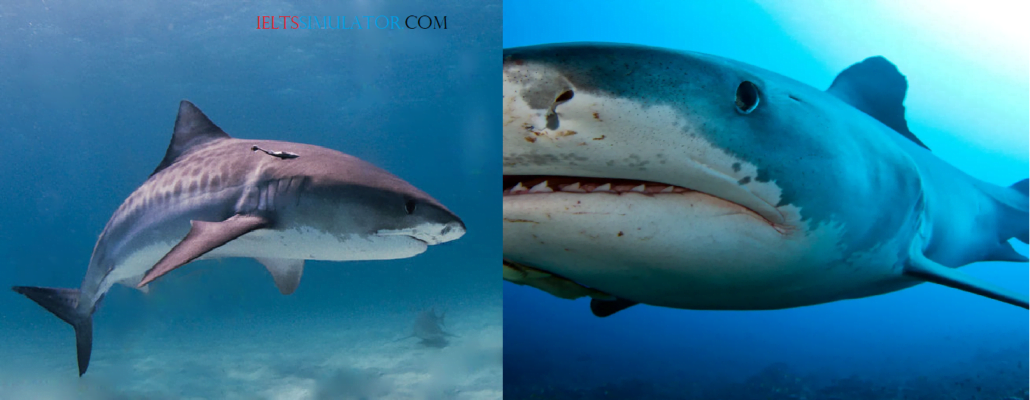
IELTS LISTENING S61T4
The Tiger Shark
Researcher: Good morning, everyone. Today, I’m going to talk about the research project I’ve been involved in on the tiger shark. First of all, some background information. The tiger shark, also known as the leopard shark, is often thought to have got its name from its aggressive nature, but in actual fact, it’s called that because it has dark bands similar to those on a tiger’s body. It is a huge creature growing up to lengths of six and a half metres. It can be found just about everywhere throughout the world’s temperate and tropical seas, but it is most often found along the Q31 coast, rather than the open sea.
Attempt full listening test…
In terms of feeding, tiger sharks tend to be most active at night and are solitary hunters. Their preferred prey includes other sharks, turtles, seabirds and dolphins, to name but a few. However, it’s not uncommon to find Q32 garbage in its stomach. This is because it tends to feed in areas such as harbours and river inlets, where there is a lot of human activity.
Now to the project itself. We are particularly interested in some studies that had been done in the Raine Island area. Observations here have shown that there is a large population of tiger sharks present in the Q33 summer, during the turtle nesting season. However, during the winter months the sharks disappear – so we decided to do some of our own research there.
The first step was to tag a number of sharks so that we could follow their movements. To do this, we first needed to catch the sharks. Early in the morning, we baited lines with large bits of Q34 fish and set them in place. These lines were then Q35 checked every three or four hours. If no sharks were caught, the baits were replaced.
Once a shark had been caught on one of the baited hooks, it was pulled in close to the Q36 boat and secured so that we could carry out a number of brief activities to aid our research. This usually took no more than about ten minutes and was carried out as carefully as possible to minimise any stress to the shark. Each of the tiger sharks that we caught was measured and fitted with an identification tag and also a small amount of tissue was taken for genetic studies. For some larger sharks over three metres long, we also inserted into the belly a special acoustic tag capable of sending satellite signals, while on other large sharks we attached a Q37 camera to the dorsal fin, to enable us to study the behaviour and habitat use of the sharks. After this, the shark was Q38 released, and we were able to follow its movements.
So what was the purpose of all this tagging? Well, while we were already familiar with some aspects of the tiger sharks’ behaviour and food sources, what we hoped to do in this project was to see exactly what factors affected the Q39 migration patterns of tiger sharks and whether it was in fact food, weather and reproductive needs.
These are some of our findings: On February 21st a large female shark, whom we named Natalie, was attracted to our research boat at the northern tip of Raine Island and fitted with one of the satellite tags I’ve just mentioned. No transmissions were received from Natalie between April 2nd and April 29th indicating that she didn’t surface to feed during this period. The area in which she was last reported is very shallow, suggesting that she may have changed her feeding preferences during this period to focus on prey found on the sea floor.
We also made a number of other discoveries thanks to the various transmitters we used. It seems that tiger sharks move back and forth between the ocean floor and the surface quite often. This may help the sharks conserve energy while they swim, but it probably also helps them hunt, since this movement back and forth maximises its chances of not being detected by its prey until the last minute.
So far our findings have not been conclusive. However, we have gained some very interesting insights into the behaviour of tiger sharks and are now hoping to develop our research further.